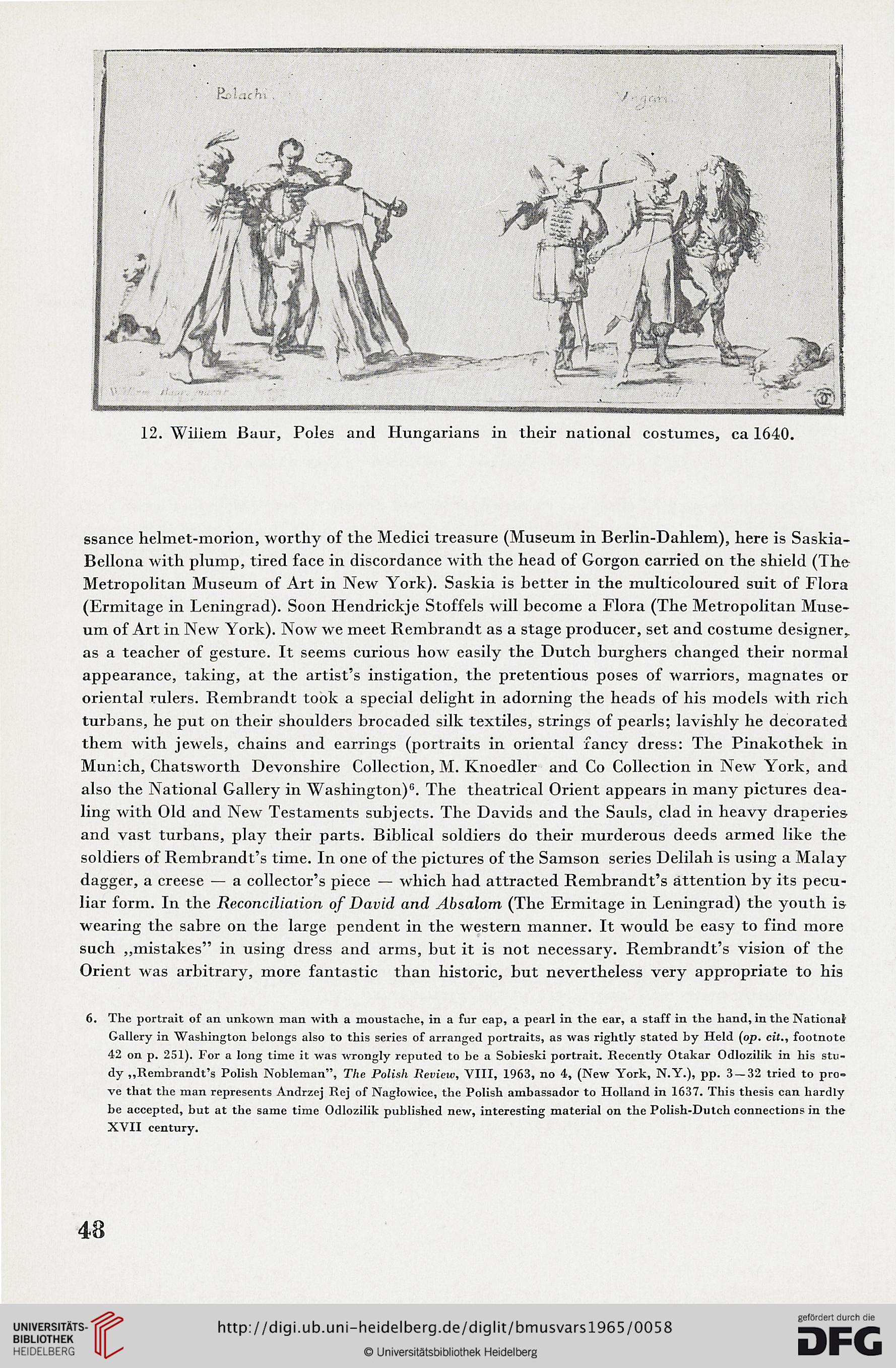12. Wiiiem Baur, Poles and Hungarians in their national costumcs, ca 1640.
ssance helmet-morion, worthy of the Medici treasure (Museum in Berlin-Dahlem), liere is Saskia-
Bellona with plump, tired face in discordance with the head of Gorgon carried on the shield (The
Metropolitan Museum of Art in New York). Saskia is better in the multicoloured suit of Flora
(Ermitage in Leningrad). Soon Hendrickje Stoffels will become a Flora (The Metropolitan Muse-
um of Art in New York). Now we meet Rembrandt as a stage producer, set and costume designer,
as a teacher of gesture. It seems curious how easily the Dutch burghers changed their normal
appearance, taking, at the artist's instigation, the pretentious poses of warriors, magnates or
oriental rulers. Rembrandt took a special delight in adorning the heads of his models with rich
turbans, he put on their shoulders brocaded silk textiles, strings of pearls; lavishly he decorated
them with jewels, chains and earrings (portraits in oriental fancy dress: The Pinakothek in
Munich, Chatsworth Devonshire Collection, M. Knoedler and Co Collection in New York, and
also the National Gallery in Washington)0. The theatrical Orient appears in many pictures dea-
ling with Old and New Testaments subjects. The Davids and the Sauls, clad in heavy draperies
and vast turbans, play their parts. Biblical soldiers do their murderous deeds armed like the
soldiers of Rembrandt's time. In one of the pictures of the Samson series Delilah is using a Malay
dagger, a creese — a collector's piece — which had attracted Rembrandt's attention by its pecu-
liar form. In the Reconciliałion of David and Absałom (The Ermitage in Leningrad) the youth ia
wearing the sabre on the large pendent in the western manner. It would be easy to find more
such „mistakes" in using dress and arms, but it is not necessary. Rembrandt's vision of the
Orient was arbitrary, more fantastic than historie, but nevertheless very appropriate to his
6. The portrait of an unkown man with a moustache, in a fur cap, a pcarl in the car, a Staff in the hand, in the National'
Gallery in Washington belongs also to this series of arranged portraits, as was rightly stated by Hcld (op. cit., footnote
42 on p. 251). For a Iong time it was wrongly reputed to he a Sobieski portrait. Reeently Otakar Odlozilik in his stu-
dy „Rembrandt's Polish Nobleman", The Polish Itmiiew, VIII, 1963, no 4, (New York, N.Y.), pp. 3 — 32 tried to pro-
ve that the man represents Andrzej Rej of Nagłowice, the Polish ambassador to Holland in 1637. This thesis can hardly
be accepted, but at the same time Odlozilik published new, interesting materiał on the Polish-Dutch connections in the
XVII century.
48
ssance helmet-morion, worthy of the Medici treasure (Museum in Berlin-Dahlem), liere is Saskia-
Bellona with plump, tired face in discordance with the head of Gorgon carried on the shield (The
Metropolitan Museum of Art in New York). Saskia is better in the multicoloured suit of Flora
(Ermitage in Leningrad). Soon Hendrickje Stoffels will become a Flora (The Metropolitan Muse-
um of Art in New York). Now we meet Rembrandt as a stage producer, set and costume designer,
as a teacher of gesture. It seems curious how easily the Dutch burghers changed their normal
appearance, taking, at the artist's instigation, the pretentious poses of warriors, magnates or
oriental rulers. Rembrandt took a special delight in adorning the heads of his models with rich
turbans, he put on their shoulders brocaded silk textiles, strings of pearls; lavishly he decorated
them with jewels, chains and earrings (portraits in oriental fancy dress: The Pinakothek in
Munich, Chatsworth Devonshire Collection, M. Knoedler and Co Collection in New York, and
also the National Gallery in Washington)0. The theatrical Orient appears in many pictures dea-
ling with Old and New Testaments subjects. The Davids and the Sauls, clad in heavy draperies
and vast turbans, play their parts. Biblical soldiers do their murderous deeds armed like the
soldiers of Rembrandt's time. In one of the pictures of the Samson series Delilah is using a Malay
dagger, a creese — a collector's piece — which had attracted Rembrandt's attention by its pecu-
liar form. In the Reconciliałion of David and Absałom (The Ermitage in Leningrad) the youth ia
wearing the sabre on the large pendent in the western manner. It would be easy to find more
such „mistakes" in using dress and arms, but it is not necessary. Rembrandt's vision of the
Orient was arbitrary, more fantastic than historie, but nevertheless very appropriate to his
6. The portrait of an unkown man with a moustache, in a fur cap, a pcarl in the car, a Staff in the hand, in the National'
Gallery in Washington belongs also to this series of arranged portraits, as was rightly stated by Hcld (op. cit., footnote
42 on p. 251). For a Iong time it was wrongly reputed to he a Sobieski portrait. Reeently Otakar Odlozilik in his stu-
dy „Rembrandt's Polish Nobleman", The Polish Itmiiew, VIII, 1963, no 4, (New York, N.Y.), pp. 3 — 32 tried to pro-
ve that the man represents Andrzej Rej of Nagłowice, the Polish ambassador to Holland in 1637. This thesis can hardly
be accepted, but at the same time Odlozilik published new, interesting materiał on the Polish-Dutch connections in the
XVII century.
48




